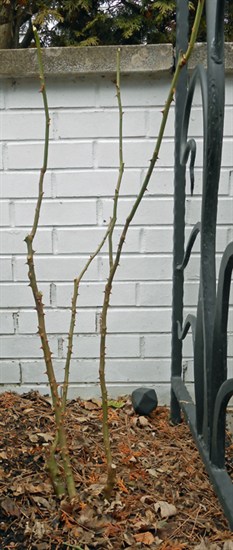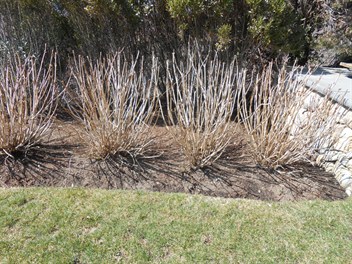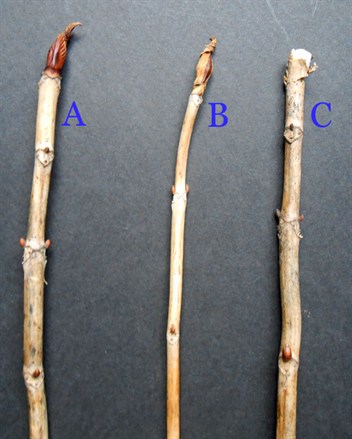Roses and Hydrangea teach the lesson
Don't leave that thin, spindly
stuff!
- Mr. Kissinger to John Macunovich,
thence to Janet -
If part of a rose or shrub grew poorly last year, don't expect
it to somehow produce bigger and better this year. Plants grow in
much more regimented fashion -- every limb produces branches a bit
smaller than itself.
So cut back to stout, healthy wood, even if that means cutting
'way back to the base.
See it applied to roses or to mophead Hydrangea (blue or pink) with a side
lesson in Hydrangeas that refuse to
bloom.
This article is Sponsored by:
Roses excel when cut hard
Here we prune two roses, one grown as a rambler (shrubby in form
but able to reach high and appreciative of support against a
trellis at its extremities) and a typical climbing rose (with very
long, relatively weak canes that require support to prevent
sprawling).
To prune a rambler rose:
1) Cut out all weak and damaged canes. Remove them right at the
base of the plant or clip them back to a main branch, leaving a
stub if it's husky and undamaged.
2) Shorten the remaining canes.
Below: Before and after pruning. Blue arrows mark weak- and
damaged canes. Yellow arrows indicate how low we cut to remove
those weaklings.


Below: Several weeks later as spring commences in
earnest.

Prune a climbing rose:
1) Cut out all weak and damaged canes. Remove them right at the
base of the plant or clip them back to a main branch, leaving a
stub if it's husky and undamaged.
2) Identify the main canes, those you trained to fan across the
trellis or wrap up a post. Shorten them to allow new strong growth
at the tip and encourage more "breaks" (new side branches, the
places where flowers will be borne). If a main cane is growing
vertically, look for a way to lower it toward horizontal or create
more horizontal sections by winding them around a post, spiral
fashion them. Vertical canes tend to have breaks and blooms only at
the top; canes growing more horizontally develop more breaks and
flowers all along their length.
3) Think about the future. If a main cane is becoming old and
less productive, leave a new basal shoot to grow so you can train
it in next year when you remove the old cane.


Below: Husky shoots emerge from the canes we left in place.
These side shoots are what will bear the flowers.

To see other rose cutbacks: Knockout rose, miniature climbing rose, heirloom climbing rose, old
rose/shrub rose, and summer pruning of various roses.
Blue Hydrangea
digs discipline
My hydrangeas bloom but they flop
unless I stake them!
- July chorus -
We've bred Hydrangea varieties for such massive blooms
that only the sturdiest stems can support them. Your best bet is to
thin the shrub each year to stout wood. This has the additional
effect of keeping the plant shorter than it would otherwise be -- 3
or 4 feet tall rather than 5 feet or more.
Here's what we do to blue mophead Hydrangea. (H.
macrophylla varieties and hybrids, blue or pink blooms in mid-
to late summer.)
1) In early spring, cut out all weak canes. Clip them right to
the ground.
2) Cut out the oldest canes -- those most woody and most
branched. (These will produce flowers only on side branches thinner
than themselves.)
3) Thin more as needed to allow each cane room to develop leaves
right to its base.
Below: A hedge of blue Hydrangea before (left),
during (right) and after (lower left) our cut. Most wood that
remains is stout and unbranched.




Above, right: Comparing the three types of canes
involved.
The catch: Hydrangeas that
refuse to bloom
Some people say: "I pruned it this way, I pruned it that way,
and it didn't bloom either way!"
Check the tip bud in spring to learn the story.
Hydrangea macrophylla and H. serrata -- all of
the blue- and pink blooming varieties, whether ball-shaped or
lace-cap in bloom -- need more than one season to produce a flower.
(This is quite different from the white snowball- and panicle
species, H. arborescens including Annabelle' and H.
paniculata including PeeGee', which bloom on brand new
wood.)
The tip bud on a blue- or pink-blooming Hydrangea
branch must prepare itself in year one and survive to year two or
that branch will not bloom. In some regions, including the North
American midsection, these shrubs are hardy in their roots but the
tips do not survive. Those plants live but never or rarely bloom
after their planting year.
You can know if you have summer bloom coming in spring, by
checking for signs of life and vigor -- plumpness, moisture and
color.
Below: A is lively and moist, B is drier, shrunken, and C
has no chance to bloom since a deer nipped the bud clean off during
winter. (Don't be hard on the deer. Sometimes the gardener is the
one who makes the mistake of pruning it off.)


Below, a cutaway view of Bud A (left) and B (right): Cut the
bud to see the story. Bud A is in good shape; now if it can simply
avoid being killed by a spring frost once it begins growing, it's a
shoo-in to bloom. The brown rotted portions in B are winter damage
-- the cells burst and died there.


Below: Buds from the examples we showed being pruned in this
article -- Cape Cod Hydrangeas. They grow in a long-fall,
moist winter climate very conducive to keeping tip buds alive. Not
only did these buds survive winter but once they begin growing in
spring they are only rarely threatened by late spring
frosts.



Sponsored by
Seal
Click to an interactive list of articles recommended by our
Sponsors.